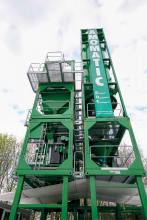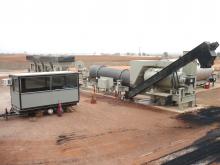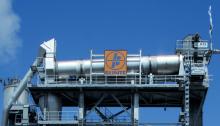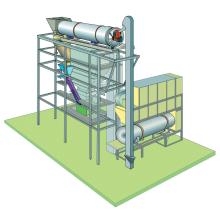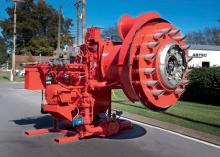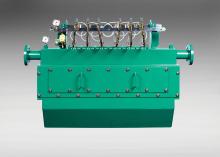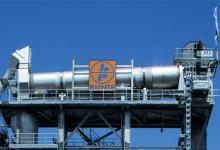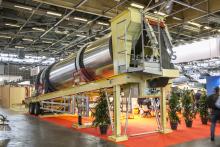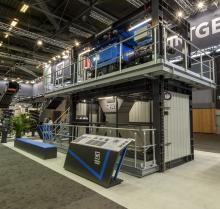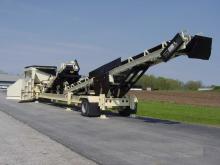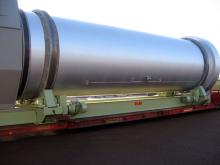Cutting-edge RAP production technology and other key asphalt plant equipment in demand globally is examined by Guy Woodford Grossmann, a building services company based in south-east Germany, is now using a state-of-the-art Benninghoven Competence BA 4000 asphalt plant to produce asphalt. Equipped with Benninghoven’s Hot Recycling System RA 180, the plant is said to be highly efficient, economical and one of the most powerful available.

Asphalt Drum Mixers (ADM) now offers stationary and self-erect storage silos compatible with its own and similar models of asphalt plants
Cutting-edge RAP production technology and other key asphalt plant equipment in demand globally is examined by Guy Woodford
Grossmann, a building services company based in south-east Germany, is now using a state-of-the-art167 Benninghoven Competence BA 4000 asphalt plant to produce asphalt. Equipped with Benninghoven’s Hot Recycling System RA 180, the plant is said to be highly efficient, economical and one of the most powerful available.
The Competence BA 4000 model supplied to Grossmann became operational, including production with RAP (Recycled Asphalt Pavement), five months ago, having been initially delivered to Grossmann’s Rosenheim HQ in February 2013.
The existing bitumen supply and parts from the cold feed system are said by Benninghoven to have been expertly integrated into the new plant without difficulty.
Despite the storms that raged in Germany in late May 2013, the Benninghoven installation team continued ITS difficult work in order to meet a fixed deadline.
The plant is equipped with the powerful Benninghoven EVO JET burner which can be operated with coal dust, oil and gas. The technologically advanced and trendsetting Benninghoven dust collection system has also been installed in the plant, which comes with a mixed material silo arrangement offering 418tonne capacity in nine bins.
As well as ITS Hot Recycling System RA 180, the Competence BA 4000 asphalt plant contains the highly flexible Multivariable RAP Cold Feed System into the mixer. This flexibility is said to be achieved through the two recycling cold feed hoppers and the two buffer silos integrated within the plant.
The plant’s dosing belt is mounted on four load cells and the RAP-granulate accurately weighed before the batch is fed into the mixer. Due to this dosing being even and continuous rather than a single surge load, the absorption of steam is constant and controlled. This system is said by Benninghoven to enable the delivery of 40% cold RAP.
The Benninghoven Control System BLS 3000 for the asphalt plant is an innovative system with all operating elements clearly displayed on the plant overview screen. The system enables the operator to capture all necessary parameters to create optimum cost estimations. Also, the control cabin with large windows gives a good overview of the plant area.
Benninghoven is confident that the asphalt plant will provide long-time reliability and aid continued success for Grossmann.
Astec’s V-Pack Stack Temperature Control System is said to offer a solution to problems dealing with today’s wide range of asphalt mix types. The system’s ‘V-flights’: novel, patent-pending drum flights with a deep V-shape, and use of variable frequency drives (VFDs), which provide control of the drum rotational speed, are keys to ITS managing of an asphalt plant’s exhaust gas temperature, while also improving overall efficiency.
The patent-pending Stack Temperature Control System automatically Controls exhaust gas temperature across a range of mix types and operating conditions by making drum speed changes. The system keeps baghouse temperature relatively stable as mix temperature changes and even as mix types change from hot mix to warm mix, from virgin to high RAP, and from dense graded to open graded mixes.1250 Astec claims that these kinds of production changes would cause baghouse temperature changes of over 38°C without the V-Pack Stack Temperature Control System.
This specially designed system increases or decreases aggregate showering in the drum as necessary to maintain consistent exhaust gas temperature, said to greatly improve the performance of the dryer.
Without such control, as the exhaust temperature of the dryer increases over 190°C, the risk of damaging the bags in the baghouse increases and, if the exhaust temperature falls below 104°C, another possible danger can be mud deposits forming in the baghouse and in the feed end of a counter flow dryer or within the exhaust ductwork itself. With mud amassing throughout the system, the plant’s operation may cease.
Astec says that in the case of a plant operating without the V-Pack stack temperature control, if the plant feed changes from 100% virgin materials warm mix to a high-percentage RAP (reclaimed asphalt pavement) base or to an open-graded mix, then some showering flights may have to be added in the drum to prevent overheating the baghouse.
Temperature variations are caused by changes in the amount of aggregate surface area in the air in the drum. For example, when making dense-graded virgin mix, the flights will tend to be fuller. The mix itself has a great deal of surface area, which results in a normal stack temperature. However, when making a higher percentage RAP mix, the flights are usually less than half full. The aggregate veil will have a big hole in it on the uplift side of the drum. With less aggregate in the air and a big hole in the veil, less surface area is exposed and stack temperature rises. And as stack temperature rises, production rate drops.
The Astec stack temperature control system monitors the exhaust gas temperatures at the baghouse inlet as the primary reference for control. As the exhaust gas temperature rises, the control system checks it against a set point. When the temperature exceeds the set point, the control system quickens the drum rotation, controlling temperature to the set point. The drum speed can be varied by the system from a minimum of about 7rpm to a maximum of about 12rpm (8rpm is the normal speed for Astec drums without this system).
The system’s V-flights are used to produce a uniform veil of virgin aggregate across the entire drum, regardless of how full the drum is, the plant’s production rate, or the RAP percentage used. This is what enables drum speed changes to be effective as a means of controlling stack temperature. Since the V-flights shower uniformly without regard to how much material is in them, they never leave a hole in the veil. More revolutions per minute place more aggregate in the air (increased veil density).
An in-built combination of V-flights, variable frequency drive, and specialised automatic controls make it easy for the temperature control system to produce mixes of all types from warm mix to open graded friction course, and to high RAP mixes without stack temperature problems. At the same time, the system maximises fuel efficiency by keeping the dryer’s heat transfer efficiency high.
Asphalt Drum Mixers (ADM) now offers stationary and self-erect asphalt storage silos compatible with both its own and similar models of asphalt plants. Storage silos receive freshly mixed asphalt from a conveyor and keep it at a constant temperature until it is discharged. The stationary and self-erect designs allow them to be used in various asphalt plant configurations, and multiple capacity options are available to accommodate the output of any operation.
The capacity of ADM’s self-erect silos ranges from 27.2tonnes to 68tonnes, and stationary silo models hold between 90.7tonnes and 272.1tonnes of asphalt mix. All models are equipped with alarms to alert operators when asphalt levels are high, and they feature a fibreglass blanket insulation to provide superior heat retention while the mixture is stored. Optional oil or electric heating systems are available to ensure asphalt is kept at the desired temperature.
Each silo features a heavy-duty steel design and the barrel is continuously double welded at the seams. It steeply tapers to a 76.2cm discharge opening where a pneumatic batcher with a dual clamshell gate greatly reduces the occurrence of product segregation and coning.
Self-erect silos are transported on a gooseneck trailer with a fifth-wheel kingpin hitch. Large units feature a trailer with a quad-axle and air ride suspension. Small and midsized trailers use leaf spring suspension and either a tandem or tri-axle. The unit’s design allows the silo and conveyor to fold into the upright position quickly and easily.
Safety features on all models include skid-resistant maintenance platform, top perimeter guardrail and solid-steel toe-stop kickplate. All silos can be equipped with low material signal alarms and LC1000 loadout computers, which work in conjunction with truck scales, weight batchers or reverse (negative) weigh systems. The LC1000 allows operators to access truck loading data, job files, silo inventory and more.
Additional options for self-erect silos include remote location lubrication systems and drag conveyors with chrome carbide casing liners. Options for stationary silos include a gooseneck trailer, cone liners, loadout weigh batchers, safety discharge gates and silo recovery systems.
208 E-MAK is supplying one of ITS Green Type 240tonnes/hour asphalt plants to El Farra, a Saudi Arabian company. El Farra plans to sell the asphalt it produces with the plant to contractors working on highway construction projects in and around the Saudi Arabian capital, Riyadh.
Onur Recepgil, E-MAK’s sales manager, said El Farra is particularly keen on the Green Type plant’s 150tonne hot mix silo with double compartment, which will enable the firm to produce two batches of asphalt, possibly with differing bitumen or binder course, simultaneously. “This enables simultaneous and continuous production of a variety of asphalt,” added Recepgil.
Capable of production levels of 200-240tonnes/hour of asphalt, the Green Type series plants also come with three electrically heated 60m³ bitumen tanks.
Of the importance of the Saudi Arabian market for asphalt plant manufacturers, Recepgil said, “If I had to choose the two biggest markets in the world, they would be Russia and Saudi Arabia. Saudi Arabia has unlimited funding resources for infrastructure and E-MAK is in that market.”
6791 Ammann do Brasil, part of leading Swiss-asphalt plant manufacturers Ammann, has manufactured ITS first Prime 140 asphalt plant at ITS new plant in the city of Gravataí in southern Brazil.
The equipment was delivered to Construtora e Pavimentadora Diferencial / Zopone Engenharia (CPDZE) in Rio de Janeiro, who are looking to produce around 132,000tonnes of asphalt from June to November this year for the construction of the Metropolitan Arch in Rio de Janeiro.
A project awarded to Construtora Norberto1305 Odebrecht (CNO), the construction of the Metropolitan Arch is part of an ambitious project aimed at building a 145km highway network in the Rio de Janeiro metropolitan area, while, at the same time, integrating five federal beltways across Rio de Janeiro state.
CNO will build the Metropolitan Arch entirely with Ammann equipment. The asphalt mixture produced by the up to 140tonnes/hour Prime 140 plant will be applied by the AFT 500 asphalt paver, which has a 6.5m-wide application screed.
Ammann’s AV110 X articulated tandem rollers and AP240 pneumatic tyred rollers will also be used during the project.
The Prime 140 model from Ammann is a highly compact asphalt plant assembled on a semitrailer. ITS standard configuration has three dosing bins for virgin aggregates, with an option of using two additional bins.
The aggregates are weighed individually by dosing belts with two load cells per bin and carried to the drying drum on the collection belt for further drying through counterflow convection. The filtering system – said to be in compliance with the strictest emission standards and Ammann directives – allows customers to reduce maintenance costs.
The combination of smooth bags and the Plant 140’s exclusive counterflow cleaning system, which uses the negative pressure in the filter, is said by Ammann to eliminate the need for a compressor and significantly reduces bag wear. This system provides more eco-friendly and cost-effective filtering. With the purpose of increasing asphalt mix quality, the Prime 140 model can dose the reclaimed or added ‘filler’, such as lime and cement, by means of a gravimetric scale.
By manufacturing all the systems within the asphalt plant production chain, Ammann achieves optimum integration of the drying drum and burner. Not only are the raising fins in the convection zone and the closed fins in the burner zone designed to guarantee optimum performance, but the diameter/ length of the drying drum are designed to ensure effective drying of the aggregates, without interference by the burner flame. In fact, excellent combustion should reflect directly on fuel consumption.
The Prime 140 plant burner remains a key element with regard to operating expenses and plant emissions. The aim is to reduce daily and maintenance costs regardless of whether the plant is equipped with a mono, dual or triple fuel burner.
Grossmann, a building services company based in south-east Germany, is now using a state-of-the-art
The Competence BA 4000 model supplied to Grossmann became operational, including production with RAP (Recycled Asphalt Pavement), five months ago, having been initially delivered to Grossmann’s Rosenheim HQ in February 2013.
The existing bitumen supply and parts from the cold feed system are said by Benninghoven to have been expertly integrated into the new plant without difficulty.
Despite the storms that raged in Germany in late May 2013, the Benninghoven installation team continued ITS difficult work in order to meet a fixed deadline.
The plant is equipped with the powerful Benninghoven EVO JET burner which can be operated with coal dust, oil and gas. The technologically advanced and trendsetting Benninghoven dust collection system has also been installed in the plant, which comes with a mixed material silo arrangement offering 418tonne capacity in nine bins.
As well as ITS Hot Recycling System RA 180, the Competence BA 4000 asphalt plant contains the highly flexible Multivariable RAP Cold Feed System into the mixer. This flexibility is said to be achieved through the two recycling cold feed hoppers and the two buffer silos integrated within the plant.
The plant’s dosing belt is mounted on four load cells and the RAP-granulate accurately weighed before the batch is fed into the mixer. Due to this dosing being even and continuous rather than a single surge load, the absorption of steam is constant and controlled. This system is said by Benninghoven to enable the delivery of 40% cold RAP.
The Benninghoven Control System BLS 3000 for the asphalt plant is an innovative system with all operating elements clearly displayed on the plant overview screen. The system enables the operator to capture all necessary parameters to create optimum cost estimations. Also, the control cabin with large windows gives a good overview of the plant area.
Benninghoven is confident that the asphalt plant will provide long-time reliability and aid continued success for Grossmann.
Astec’s V-Pack Stack Temperature Control System is said to offer a solution to problems dealing with today’s wide range of asphalt mix types. The system’s ‘V-flights’: novel, patent-pending drum flights with a deep V-shape, and use of variable frequency drives (VFDs), which provide control of the drum rotational speed, are keys to ITS managing of an asphalt plant’s exhaust gas temperature, while also improving overall efficiency.
The patent-pending Stack Temperature Control System automatically Controls exhaust gas temperature across a range of mix types and operating conditions by making drum speed changes. The system keeps baghouse temperature relatively stable as mix temperature changes and even as mix types change from hot mix to warm mix, from virgin to high RAP, and from dense graded to open graded mixes.
This specially designed system increases or decreases aggregate showering in the drum as necessary to maintain consistent exhaust gas temperature, said to greatly improve the performance of the dryer.
Without such control, as the exhaust temperature of the dryer increases over 190°C, the risk of damaging the bags in the baghouse increases and, if the exhaust temperature falls below 104°C, another possible danger can be mud deposits forming in the baghouse and in the feed end of a counter flow dryer or within the exhaust ductwork itself. With mud amassing throughout the system, the plant’s operation may cease.
Astec says that in the case of a plant operating without the V-Pack stack temperature control, if the plant feed changes from 100% virgin materials warm mix to a high-percentage RAP (reclaimed asphalt pavement) base or to an open-graded mix, then some showering flights may have to be added in the drum to prevent overheating the baghouse.
Temperature variations are caused by changes in the amount of aggregate surface area in the air in the drum. For example, when making dense-graded virgin mix, the flights will tend to be fuller. The mix itself has a great deal of surface area, which results in a normal stack temperature. However, when making a higher percentage RAP mix, the flights are usually less than half full. The aggregate veil will have a big hole in it on the uplift side of the drum. With less aggregate in the air and a big hole in the veil, less surface area is exposed and stack temperature rises. And as stack temperature rises, production rate drops.
The Astec stack temperature control system monitors the exhaust gas temperatures at the baghouse inlet as the primary reference for control. As the exhaust gas temperature rises, the control system checks it against a set point. When the temperature exceeds the set point, the control system quickens the drum rotation, controlling temperature to the set point. The drum speed can be varied by the system from a minimum of about 7rpm to a maximum of about 12rpm (8rpm is the normal speed for Astec drums without this system).
The system’s V-flights are used to produce a uniform veil of virgin aggregate across the entire drum, regardless of how full the drum is, the plant’s production rate, or the RAP percentage used. This is what enables drum speed changes to be effective as a means of controlling stack temperature. Since the V-flights shower uniformly without regard to how much material is in them, they never leave a hole in the veil. More revolutions per minute place more aggregate in the air (increased veil density).
An in-built combination of V-flights, variable frequency drive, and specialised automatic controls make it easy for the temperature control system to produce mixes of all types from warm mix to open graded friction course, and to high RAP mixes without stack temperature problems. At the same time, the system maximises fuel efficiency by keeping the dryer’s heat transfer efficiency high.
Asphalt Drum Mixers (ADM) now offers stationary and self-erect asphalt storage silos compatible with both its own and similar models of asphalt plants. Storage silos receive freshly mixed asphalt from a conveyor and keep it at a constant temperature until it is discharged. The stationary and self-erect designs allow them to be used in various asphalt plant configurations, and multiple capacity options are available to accommodate the output of any operation.
The capacity of ADM’s self-erect silos ranges from 27.2tonnes to 68tonnes, and stationary silo models hold between 90.7tonnes and 272.1tonnes of asphalt mix. All models are equipped with alarms to alert operators when asphalt levels are high, and they feature a fibreglass blanket insulation to provide superior heat retention while the mixture is stored. Optional oil or electric heating systems are available to ensure asphalt is kept at the desired temperature.
Each silo features a heavy-duty steel design and the barrel is continuously double welded at the seams. It steeply tapers to a 76.2cm discharge opening where a pneumatic batcher with a dual clamshell gate greatly reduces the occurrence of product segregation and coning.
Self-erect silos are transported on a gooseneck trailer with a fifth-wheel kingpin hitch. Large units feature a trailer with a quad-axle and air ride suspension. Small and midsized trailers use leaf spring suspension and either a tandem or tri-axle. The unit’s design allows the silo and conveyor to fold into the upright position quickly and easily.
Safety features on all models include skid-resistant maintenance platform, top perimeter guardrail and solid-steel toe-stop kickplate. All silos can be equipped with low material signal alarms and LC1000 loadout computers, which work in conjunction with truck scales, weight batchers or reverse (negative) weigh systems. The LC1000 allows operators to access truck loading data, job files, silo inventory and more.
Additional options for self-erect silos include remote location lubrication systems and drag conveyors with chrome carbide casing liners. Options for stationary silos include a gooseneck trailer, cone liners, loadout weigh batchers, safety discharge gates and silo recovery systems.
Onur Recepgil, E-MAK’s sales manager, said El Farra is particularly keen on the Green Type plant’s 150tonne hot mix silo with double compartment, which will enable the firm to produce two batches of asphalt, possibly with differing bitumen or binder course, simultaneously. “This enables simultaneous and continuous production of a variety of asphalt,” added Recepgil.
Capable of production levels of 200-240tonnes/hour of asphalt, the Green Type series plants also come with three electrically heated 60m³ bitumen tanks.
Of the importance of the Saudi Arabian market for asphalt plant manufacturers, Recepgil said, “If I had to choose the two biggest markets in the world, they would be Russia and Saudi Arabia. Saudi Arabia has unlimited funding resources for infrastructure and E-MAK is in that market.”
The equipment was delivered to Construtora e Pavimentadora Diferencial / Zopone Engenharia (CPDZE) in Rio de Janeiro, who are looking to produce around 132,000tonnes of asphalt from June to November this year for the construction of the Metropolitan Arch in Rio de Janeiro.
A project awarded to Construtora Norberto
CNO will build the Metropolitan Arch entirely with Ammann equipment. The asphalt mixture produced by the up to 140tonnes/hour Prime 140 plant will be applied by the AFT 500 asphalt paver, which has a 6.5m-wide application screed.
Ammann’s AV110 X articulated tandem rollers and AP240 pneumatic tyred rollers will also be used during the project.
The Prime 140 model from Ammann is a highly compact asphalt plant assembled on a semitrailer. ITS standard configuration has three dosing bins for virgin aggregates, with an option of using two additional bins.
The aggregates are weighed individually by dosing belts with two load cells per bin and carried to the drying drum on the collection belt for further drying through counterflow convection. The filtering system – said to be in compliance with the strictest emission standards and Ammann directives – allows customers to reduce maintenance costs.
The combination of smooth bags and the Plant 140’s exclusive counterflow cleaning system, which uses the negative pressure in the filter, is said by Ammann to eliminate the need for a compressor and significantly reduces bag wear. This system provides more eco-friendly and cost-effective filtering. With the purpose of increasing asphalt mix quality, the Prime 140 model can dose the reclaimed or added ‘filler’, such as lime and cement, by means of a gravimetric scale.
By manufacturing all the systems within the asphalt plant production chain, Ammann achieves optimum integration of the drying drum and burner. Not only are the raising fins in the convection zone and the closed fins in the burner zone designed to guarantee optimum performance, but the diameter/ length of the drying drum are designed to ensure effective drying of the aggregates, without interference by the burner flame. In fact, excellent combustion should reflect directly on fuel consumption.
The Prime 140 plant burner remains a key element with regard to operating expenses and plant emissions. The aim is to reduce daily and maintenance costs regardless of whether the plant is equipped with a mono, dual or triple fuel burner.

